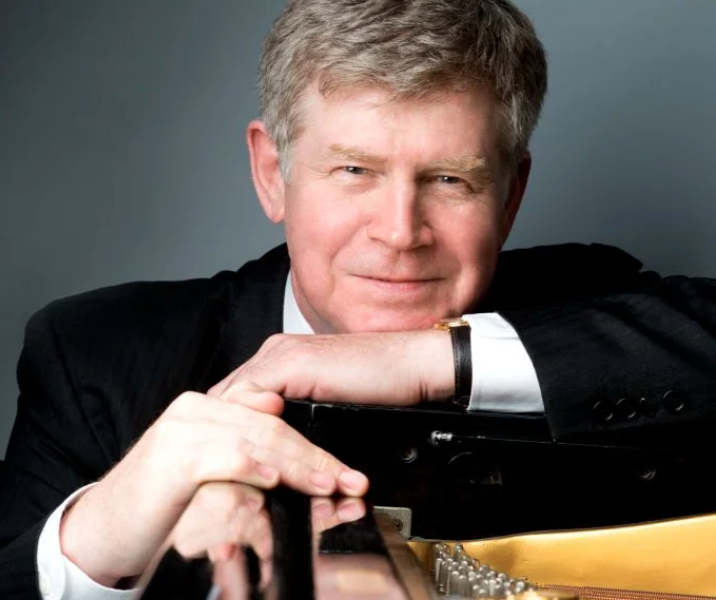Ian Hobson: The Complete Schumann Piano Works- Counterpoints in Review
Ian Hobson, piano
Tenri Cultural institute, New York, NY
May 3, 2024
This evening’s performance showcased pianist Ian Hobson performing a program featuring music exclusively by Robert Schumann (1810-1856). The program, titled Counterpoints, presented works that were composed between 1836 and 1853.
The first piece was Scherzo, Gigue, Romanza, und Fughette, Op. 32. Each movement was portrayed with a clear and distinct character by Mr. Hobson, and he maintained unity by emphasizing the continuous dotted rhythms throughout the work. Particularly notable was the third movement, Romanze, which embodied Schumann’s signature blend of heroism and passion. Mr. Hobson navigated its contrasting B-section with tender precision, seamlessly returning to the main thematic material. The final movement, Fughette, was surprisingly emotive and beautifully handled by Mr. Hobson.
Next was a set of four fugues, Vier Fugen, Op. 72, from 1845. It’s always interesting when a composer other than J.S. Bach sets out to write a fugue – one wonders about their fidelity to the form and the extent to which they retain their own style. At this time, Schumann was deeply engrossed in the study of Bach’s fugues, and it appears he remained faithful to the form. Mr. Hobson skillfully delineated each voice while also capturing the introspective and wandering quality inherent in these fugues, particularly in the first one. The second fugue had great energy and the ending was particularly exciting when the organ-like dominant pedal points emerged. The third fugue proved to be the most Schumannesque – it highlighted the characteristic ambiguity that is present in much of his music. Mr. Hobson worked beautifully with the harmonic tension of the highly chromatic lines to communicate the expression (ausdrucksvoll) the piece demanded. The fourth piece was charming and played with great care.
The second half of the program began with another lesser-known work, Sieben Stücke in Fughettenform (Seven Pieces in Fugue Form), Op. 126, from 1853. These compositions served as counterpoint exercises for Schumann himself, and perhaps he didn’t originally intend for them to be performed on the concert stage. However, they possess a striking beauty, and I’m grateful that Mr. Hobson chose to share these works with us tonight. Despite their brevity, each piece managed to convey a rich emotional world, and Mr. Hobson’s performance skillfully brought out their essence, with a lush sound and meticulous attention to each entrance. Number IV. Lebhaft was particularly interesting as it had a wonderful rhythmic drive. Number VI. Sehr Schnell almost seemed modern and Number VII. Langsam, ausdrucksvoll communicated an obscure austerity.
The final piece on the program was Kriesleriana, Op. 16 – a staple in the piano repertoire. To hear his work among the more underperformed repertoire was fascinating – one can make the connections to counterpoint and where Schumann’s interests were at the time. Tonight Mr. Hobson performed the original version which Clara Schumann herself edited and performed because “it is wilder.” And wild it was!
Each of the eight movements alternates between moments of furious drama and dream-like reverie—some reminiscent of Florestan, others of Eusebius. Mr. Hobson expertly created contrast while still sustaining the intrigue in the fantasy aspect of the piece. The first movement, Äußerst bewegt (Extremely animated), began boldly, plunging us into the heart of the drama. Mr. Hobson played with a spontaneity fitting for a movement of such intensity. The connections to counterpoint were unmistakably apparent in the contrasting middle section. The pensive second movement, Sehr innig und nicht zu rasch (Very inwardly and not too quickly) had a good flow which can be a challenge due to the length of this movement with its repeats. The return to the A-section was particularly special. The following movement, Sehr aufgeregt (Very agitated), had a heroic character from the outset which ended with an exciting flourish handled with bravura. The fourth movement, Sehr langsam (Very slowly), presents another challenge in terms of pacing. This movement could have been helped with perhaps a more fantasy-like approach. However, the B-section was beautifully sculpted and the return to the A-section was a revelation.
Another highly contrapuntal movement is the fifth, Sehr lebhaft (Very lively), characterized by its moody shifts and long-note entrances. While Mr. Hobson captured the essence of the work, a more grounded pulse and suppler sense of the syncopated counterpoint would have enhanced the performance.
Movement six, Sehr langsam (Very slowly) was among my favorites of the evening. Mr. Hobson communicated with a generosity and honesty that was deeply moving. The final movement of this phenomenal work is entitled Schnell und spielend (Fast and playful). This final piece of this remarkable work was delivered with abandon, providing a satisfying conclusion to the evening.
Typically, programs featuring only one composer are not ones I tend to seek out. However, this evening had a specific idea that was very thoughtfully curated – counterpoints. As the program went on, the audience was invited to create relationships between the works, Schumann’s life at the time and his connection to counterpoint and his study of fugues- and not only that, but Mr. Hobson also treated us to a program full of passion, vigor, and commitment.
He will be performing another all-Schumann recital on Friday, May 10 also at the Tenri Cultural Institute. Do not miss this remarkable musician!
by Walter Aparicio for New York Concert Review; New York, NY

